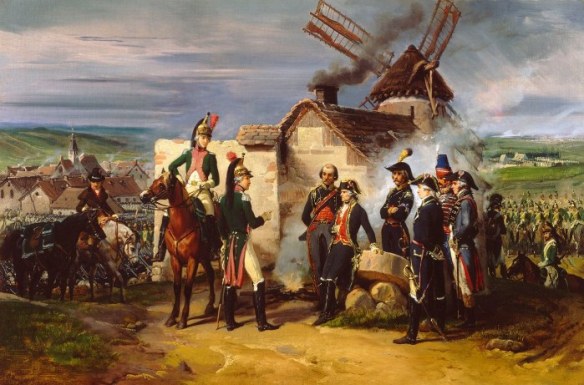The Duke of Chartres, on foot at left, and his brother, the Duke of Montpensier on horseback, are shown in green dragoon uniforms at Valmy.
French volunteers of the young republic (left) stand in stark contrast to the well-groomed regulars at right. At Valmy, the citizen soldiers proved they could stand up to enemy fire.
Some of Kellermann’s volunteers had already pleasantly surprised their commanders. One of the Duke of Chartres’ battalions was made up of new recruits. Its men refused orders to remain in the rear and guard the baggage trains. Confronted by the duke, a spokesman said, “General, we are here to defend our country, and we entreat you not to require any of us to leave the standard of our battalion for the purpose of guarding the baggage.”
“Very well,” answered the duke, “your baggage must take care of itself for today, and your battalion shall march along with your fellow soldiers of the line.”
(1773–1850)
The young Louis Philippe d’Orleans, Duke of Chartres, calm and highly visible on his horse amid the turmoil, lent his aid to the line officers as they steadied and reformed their battalions. Only 19 years old, the duke’s high rank as a division commander was due to his status as the son of the Duke of Orleans, one of France’s wealthiest men and the head of the cadet branch of the royal family. “I have never seen a general as young as you,” Dumouriez said upon their first meeting. “I am the son of the man who made you a colonel, and I am entirely at your service,” the duke replied.
#
King of the French from 1830 to 1848, Louis Philippe I was the son of Louis-Philippe-Joseph, duke of ORLÉANS (known as PHILIPPE ÉGALITÉ), and Louise-Marie de Bourbon-Penthievre. He bore the titles successively of duke of Valois, of Chartres (1785), and of Orléans (on the death of his father in 1793). Raised with his sister, the future Madame ADÉLAIDE, by Mme de Genlis, he was, like his father, a fervent supporter of revolutionary ideas. A member of the JACOBINS, he distinguished himself as an officer at the Battles of Valmy and Jemappes (1792).
Dumouriez had ordered Ferrand to take Jemappes, while at noon he launched his hammer blow. Supported by the cavalry and led by several artillery batteries, Chartres’ center and Beurnonville’s right advanced toward the ridgeline, formed in attack columns deployed en echequier (chessboard style). When they reached a range of 160 meters, Beurnonville deployed eight battalions and charged the Austrian center, taking several guns. Three Austrian cavalry squadrons countercharged, putting the French infantry to flight as reinforcements were rushed to the center.
The French commanders rallied Beurnonville’s fleeing infantry, while Chartres reordered his men to form the massive bataillon de Mons column. Followed by two regiments, the column advanced and retook the Cuesmes ridge, beating off Austrian counterattacks. On the French left Ferrand, with a 4-to-1 advantage, was encircling Jemappes with fifteen infantry battalions and cavalry. After initial slow progress south of the village, he took the small hill, although two grenadier battalions halted the next French advance on the village.
After the execution of his father, Louis-Philippe remained in exile, traveling and teaching mathematics and languages in Ger many, Scandinavia, the United States, and England. In 1809, he married his cousin, Marie-Amélie, who was King Ferdinand IV of Naples’s daughter. They had eight children. He returned to France after the abdication of NAPOLÉON I and was welcomed by LOUIS XVIII, who restored him to the Orléans estates. As the son of a former regicide, however, he was kept out of the court and out of political life. In the late 1820s, he became the favorite of the middle and lower classes, who had grown restive under the reactionary rule of CHARLES X.
In the JULY REVOLUTION OF 1830, which overthrew Charles, Louis Philippe, brought to power by the wealthy bourgeoisie, was proclaimed king of the French by the Chamber of Deputies. At first content to rule as a “citizen-king,” he conciliated the republicans who brought him to power, and dispensed with many royal privileges, beginning what is known as the JULY MONARCHY. He had also supported, more or less, such liberal newspapers as Le Constitutionnel and later Le National. Gradually, however, he became more authoritarian and sought to rule as well as to reign (see FRANÇOIS GUIZOT). The last years of his monarchy were marked by corruption and failures in both domestic and foreign affairs, and he was eventually deserted by both the democratic and the authoritarian elements. He was deposed by the REVOLUTION OF 1848 and, after his abdication, went into exile in England, where he died two years later.
